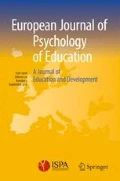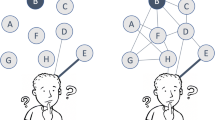Abstract
This study describes an in-depth investigation of students’ integration or connection formation across multiple texts. Students were asked to complete two multiple text tasks, differing in the number of texts that they asked students to connect and the variety of cross-textual connections able to be formed. For each task, students were asked to indicate (e.g., highlight) and explain each connection formed. Students’ connection formation was analyzed in a variety of ways (e.g., number of texts connected, types of connections identified). Across two tasks, students were found (a) to form more evidentiary (i.e., linking specific information supporting main ideas) than thematic (i.e., linking main ideas across texts) connections, (b) to identify more similarities than differences, and (c) to form comparatively low-level, rather than high-level connections, with levels of connection formation distinguished according to the degree of specificity, abstraction, and elaboration that these reflected. Implications for further research and instruction are discussed.



Similar content being viewed by others
References
Anmarkrud, Ø., Bråten, I., & Strømsø, H. I. (2014). Multiple-documents literacy: Strategic processing, source awareness, and argumentation when reading multiple conflicting documents. Learning and Individual Differences, 30, 64–76. https://doi.org/10.1016/j.lindif.2013.01.007.
Barzilai, S., Zohar, A. R., & Mor-Hagani, S. (2018). Promoting integration of multiple texts: a review of instructional approaches and practices. Educational Psychology Review, 30(3), 973–999. https://doi.org/10.1007/s10648-018-9436-8.
Britt, M. A., Rouet, J. F., & Braasch, J. L. G. (2012). Documents as entities: Extending the situation model theory of comprehension. In M. A. Britt, S. R. Goldman, & J.-F. Rouet (Eds.), Reading: From words to multiple texts (pp. 160–179). New York, NY: Routledge.
Britt, M. A., & Aglinskas, C. (2002). Improving students’ ability to identify and use source information. Cognition and Instruction, 20(4), 485–522. https://doi.org/10.1207/S1532690XCI20042.
Britt, M. A., Perfetti, C. A., Sandak, R., & Rouet, J.-F. (1999). Content Integration and source separation in learning from multiple texts. In S. R. Goldman, A. C. Graesser, & P. van den Broek (Eds.), Narrative comprehension, causality, and coherence: Essays in honor of Tom Trabasso (pp. 209–233). Mahwah, NJ: Lawrence Erlbaum Associates, Inc.
Cerdán, R., & Vidal-Abarca, E. (2008). The effects of tasks on integrating information from multiple documents. Journal of Educational Psychology, 100(1), 209–222. https://doi.org/10.1037/0022-0663.100.1.209.
Du, H., & List, A. (2020). Researching and writing based on multiple texts. Learning and Instruction, 66. https://doi.org/10.1016/j.learninstruc.2019.101297
Goldman, S. R. (2004). Cognitive aspects of constructing meaning through and across multiple texts. In N. Shuart-Faris & D. Bloome (Eds.), Uses of intertextuality in classroom and educational research (pp. 317–352). Greenwich, CT: Information Age.
Goldman, S. R., & Scardamalia, M. (2013). Managing, understanding, applying, and creating knowledge in the information age: next-generation challenges and opportunities. Cognition and Instruction, 31(2), 255–269. https://doi.org/10.1080/10824669.2013.773217.
Goldman, S. R., Braasch, J. L., Wiley, J., Graesser, A. C., & Brodowinska, K. (2012). Comprehending and learning from Internet sources: Processing patterns of better and poorer learners. Reading Research Quarterly, 47(4), 356–381. https://doi.org/10.1002/RRQ.027.
Kiili, C., Coiro, J., & Hämäläinen, J. (2016). An online inquiry tool to support the exploration of controversial issues on the Internet. Journal of Literacy and Technology, 17, 31–52 Retrieved from http://www.literacyandtechnology.org/uploads/1/3/6/8/136889/jltsp2016killicoirohamaianen.pdf.
Kurby, C. A., Britt, M. A., & Magliano, J. P. (2005). The role of top-down and bottom-up processes in between-text integration. Reading Psychology, 26(4-5), 335–362. https://doi.org/10.1080/02702710500285870.
Lankshear, C. (1999). Literacy studies in education: Disciplined developments in a post-disciplinary age. In M. Peters (Ed.), After the disciplines: The emergence of cultural studies (pp. 199–228). Westport, CT: Greenwood Publishing.
List, A., Du, H., Wang, Y., & Lee, H. Y. (2019). Toward a typology of integration: Examining the documents model framework. Contemporary Educational Psychology, 58, 228–242. https://doi.org/10.1016/j.cedpsych.2019.03.003.
List, A., & Alexander, P. A. (2019). Toward an integrated framework of multiple text use. Educational Psychologist, 54(1), 20–39. https://doi.org/10.1080/00461520.2018.1505514.
List, A., Du, H., Wang, Y., & Lee, H. Y. (2019). Toward a typology of integration: Examining the documents model framework. Contemporary Educational Psychology, 58, 228-242. https://doi.org/10.1016/j.cedpsych.2019.03.003.
List, A. (2019). Drawing is Integrating: An Examination of Students’ Graphic Representations of Multiple Texts. Reading Psychology, 40(6), 491-524. https://doi.org/10.1080/02702711.2019.1629517
List, A., & Alexander, P. K. (2018). Cold and warm perspectives on the Cognitive Affective Engagement Model of multiple source use. In J. L. G. Braasch, I. Bråten, & M. T. McCrudden (Eds.), Handbook of multiple source use (pp. 34–54). New York: Routledge.
List, A., & Alexander, P. A. (2017a). Cognitive affective engagement model of multiple source use. Educational Psychologist, 52(3), 182–199. https://doi.org/10.1080/00461520.2017.1329014.
List, A., & Alexander, P. A. (2017b). Analyzing and integrating models of multiple text comprehension. Educational Psychologist, 52(3), 143–147. https://doi.org/10.1080/00461520.2017.1328309
McNamara, D. S., Levinstein, I. B., & Boonthum, C. (2004). iSTART: Interactive strategy training for active reading and thinking. Behavior Research Methods, Instruments, & Computers, 36(2), 222–233. https://doi.org/10.3758/BF03195567.
Perfetti, C. A., Rouet, J.-F., & Britt, M. A. (1999). Toward a theory of documents representation. In H. van Oostendorp & S. R. Goldman (Eds.), The construction of mental representations during reading (pp. 99–122). Mahwah, NJ: Lawrence Erlbaum Associates, Inc..
Primor, L., & Katzir, T. (2018). Measuring multiple text integration: A review. Frontiers in Psychology, 9, 2294. https://doi.org/10.3389/fpsyg.2018.02294.
Rouet, J., & Britt, M. A. (2011). Relevance processes in multiple document comprehension. In M. T. McCrudden, J. P. Magliano, & G. Schraw (Eds.), Text relevance and learning from text (pp. 19–52). Charlotte, NC: Information Age.
Stadtler, M., Scharrer, L., Skodzik, T., & Bromme, R. (2014). Comprehending multiple documents on scientific controversies: Effects of reading goals and signaling rhetorical relationships. Discourse Processes, 51(1-2), 93–116. https://doi.org/10.1080/0163853X.2013.855535.
Strømsø, H. I., Bråten, I., & Samuelstuen, M. S. (2003). Students’ strategic use of multiple sources during expository text reading: A longitudinal think-aloud study. Cognition and Instruction, 21(2), 113–147. https://doi.org/10.1207/S1532690XCI210201.
Wiley, J., & Voss, J. F. (1999). Constructing arguments from multiple sources: Tasks that promote understanding and not just memory for text. Journal of Educational Psychology, 91(2), 301–311. https://doi.org/10.1037/0022-0663.91.2.301.
Wiley, J., Goldman, S. R., Graesser, A. C., Sanchez, C. A., Ash, I. K., & Hemmerich, J. A. (2009). Source evaluation, comprehension, and learning in Internet science inquiry tasks. American Educational Research Journal, 46(4), 1060–1106. https://doi.org/10.3102/0002831209333183.
Wolfe, M. B., & Goldman, S. R. (2005). Relations between adolescents’ text processing and reasoning. Cognition and Instruction, 23(4), 467–502. https://doi.org/10.1207/s1532690xci23042.
Author information
Authors and Affiliations
Corresponding author
Additional information
Alexandra List focuses on students’ learning from multiple texts, such as when student aim to learn about complex topics on the Internet. In particular, her work focuses on students’ higher order processing, including multiple text evaluation and integration.
Hongcui Du is interested in how students understand evidence presented across multiple texts and communicate this understanding through writing.
Hye Yeon Lee is interested in the role of self-regulation in students’ learning from multiple texts. In particular, she is interested in how students select and evaluate texts’ trustworthiness, usefulness, and comprehensibility during reading.
Select Publications:
List, A. (2019). Drawing is integrating: an examination of students’ graphic representations of multiple texts. Reading Psychology, 40(6), 491–524.
List, A., & Alexander, P. A. (2019). Toward an integrated framework of multiple text use. Educational Psychologist, 54(1), 20–39.
List, A., Du, H., Wang, Y., & Lee, H. Y. (2019). Toward a typology of integration: Examining the documents model framework. Contemporary Educational Psychology, 58, 228–242.
Publisher’s note
Springer Nature remains neutral with regard to jurisdictional claims in published maps and institutional affiliations.
Rights and permissions
About this article
Cite this article
List, A., Du, H. & Lee, H.Y. How do students integrate multiple texts? An investigation of top-down processing. Eur J Psychol Educ 36, 599–626 (2021). https://doi.org/10.1007/s10212-020-00497-y
Received:
Revised:
Accepted:
Published:
Issue Date:
DOI: https://doi.org/10.1007/s10212-020-00497-y



